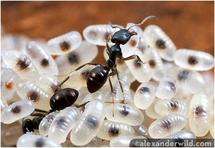Designer babies may explain insect sociality

(Phys.org)—Being able to choose the sex of their babies may be the key to the complex societies built by ants, bees, and wasps, according to Oxford University scientists.
The researchers calculated the evolutionary costs and benefits to insect mothers of choosing the sex of their offspring and showed that, if females help out with bringing up babies, then mothers prefer to have daughters rather than sons – leading to a large workforce of female helpers.
Their findings could also help to explain why termites, alone among social insects, have complex societies with a roughly equal balance of males and females: because in termite society both males and females help to raise offspring.
A report of the research is published in the March issue of the journal The American Naturalist.
'In social ants, bees, and wasps, mothers can decide the sex of their offspring by controlling which of their eggs get fertilized by sperm,' said Dr Andy Gardner of Oxford University's Department of Zoology, an author of the report. 'Fertilized eggs develop as daughters, and unfertilized eggs develop as sons. It's the daughters who do all the work in the colony, so this special ability means that the mother can raise a female workforce without wasting resources on relatively useless males.'
Previously, the sociality of ants, bees and wasps has been attributed to the curious fact that, in these species, a female is genetically more similar to her sisters than she is to her own daughters – the so-called 'haplodiploidy hypothesis'.
However, this genetic quirk does not occur in termites, which have also evolved elaborate societies. 'The failure of the haplodiploidy hypothesis to explain the sociality of termites is one of the reasons why it has gradually fallen out of favour since being proposed in the 1960s' said Dr Gardner.
Co-author Laura Ross of Oxford University's Department of Zoology points out that termite sociality is, however, fully consistent with the new 'sex-ratio adjustment' hypothesis:
'Termites are the exception that proves the rule. They can't bias the sex ratio towards females, but they don't need to, because the males do as much work as the females in their societies. We suggest that the ability and need for sex ratio adjustment explains why some insects have evolved advanced eusociality and why other insects have not.'
A report of the research, entitled 'Haplodiploidy, sex-ratio adjustment and eusociality', is to appear in the March issue of The American Naturalist.
More information: Preview of American Naturalist paper: www.zoo.ox.ac.uk/group/gardner … dnerRoss_InPress.pdf
Journal information: American Naturalist
Provided by Oxford University















